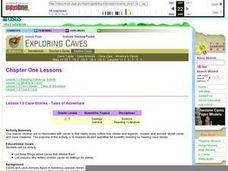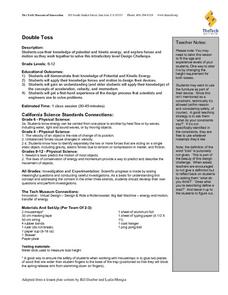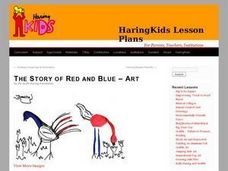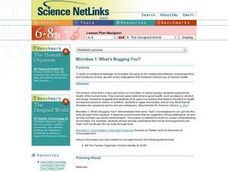Baylor College
Gases Matter
As a demonstration or as a hands-on activity, your class watches as the combination of vinegar and baking soda produce carbon dioxide gas. The intent of the lesson is to help youngsters understand that gases occupy space. It is included...
Baylor College
Water: Post-Assessment
Very simply, the science class will discuss what they have learned during The Science of Water unit and take a multiple-choice post-assessment quiz. A few other closing activities are suggested for you to choose from, such as having...
Scholastic
Frindle Lesson Plan
"Who says a pen has to be called a pen? Why not call it a frindle?" Inspired by this quote from the award-winning novel written by Andrew Celements, this lesson allows children to invent their own terms for common classroom objects,...
Novelinks
The Cure: Vocabulary Bingo
As part of their study of the vocabulary used in Sonia Levitin's The Cure, class members create a card, filling in words from the novel, and then engage in a bingo game.
Computer Science Unplugged
Twenty Guesses—Information Theory
How do we determine how much information to include and what can be left out? By playing a game of 20 questions, the class generates the best strategies for finding a number. They then move on to guessing the next letter in a short...
Annenberg Foundation
Geometry 3D Shapes: Platonic Solids
From polyhedrons to platonic solids, here is a lesson that will have your classes talking! As an introduction to platonic solids, scholars cut and fold nets to create the three-dimensional solids. They use an interactive component to...
Hildegard Center for the Arts
Mardi Gras Masks
Laissez les bons temps rouler! Create your own festive Mardi Gras masks with a lesson that provides background information on the celebration and instructions about constructing the masks.
Curated OER
The Manhattan Project
Students discover the technological and scientific requirements for making the atomic bomb, the immediate effects of an atomic bomb, and the social and political changes that have resulted from the Manhattan Project.
Curated OER
Should Soil Be Sterile?
Students determine if the sterilization of topsoil is beneficial to seed germination and plant growth. They grow plants alongside control groups, make and record observations of plant growth and measure plant biomass.
Curated OER
Water Creates a Cave
Students study the role of water in limestone cave formation and create a cave on karst-like grid on paper.
Curated OER
Cave Stories - Tales of Adventure
Students list three things about caves that interest them and list reasons why writers choose caves as settings for stories.
Curated OER
Styrofoam Relief Prints
Using Styrofoam trays, kindergartners carve and create their own prints. They create an image in the Styrofoam, ink it up, and then use it to create prints. It would be great to mention and show how ink blocks or block prints have been...
Curated OER
Double Toss
Students experiment with potential and kinetic energy. They design a device that will toss a ball at least 30 centimeters, catch it and to the ball up again.
Curated OER
Prosperity and Challenges
High schoolers watch a slideshow about the technological advances in agriculture. After viewing, they complete an index card about one aspect of the slideshow. In groups, they create a cause and effect timeline in which they identify...
Curated OER
Guerilla Warfare During The Boer War
Tenth graders define guerilla warfare in relation to the Boer War. Students explain the relationship between the British and the Boers through the analysis of a primary source document, which is included in the instructional activity.
Baylor College
Digestion
Digestion is an amazing and complicated process that provides humans with the energy they need to survive. Lesson six in this series on the science of food uses sliced turkey and a meat tenderizer to demonstrate how enzymes help break...
Baylor College
About Air
Give your class a colorful and tasty representation of the components of the mixture that we call air. Pop a few batches of popcorn in four different colors, one to represent each gas: nitrogen, oxygen, argon, and carbon dioxide. The...
Curated OER
Building a Trading Post: How to Choose a Site
Students brainstorm what kinds considerations might have to be made when building a trading post. They create an artistic representation of what their trading post would look like (two- or three- dimensional).
Curated OER
POWER UP!
Students compare and contrast different energy sources and the trade-offs of using them.
Curated OER
Character Book
Young scholars discover the behavior that represents trustworthiness, respect, responsibility, fairness and caring. For this character lesson, students make a collage of pictures demonstrating good behavior.
Curated OER
The Story of Red and Blue: Art
Young scholars identify art history by examining a list of images on-line. In this painting instructional activity, students identify the work of Keith Haring by researching the Internet and discuss his style of artwork. Young scholars...
Curated OER
Mozart's Magic
Students become familiar with the young composer through his life's story and his music. They get to make some music of their own by using musical instruments that exist both online and all around them.
Curated OER
Neanderthals
Students study Neanderthals. In this Prehistoric life lesson plan, students investigate two main theories regarding the relationship between Neanderthals and modern man. Students will conduct research through several provided web sites...
Curated OER
MICROBES 1: WHAT'S BUGGIN YOU?
Middle schoolers use existing knowledge of microbes, focusing on the relationship between microorganisms and foodborne illness, as well as the implications that foodborne illness has on human health.

























